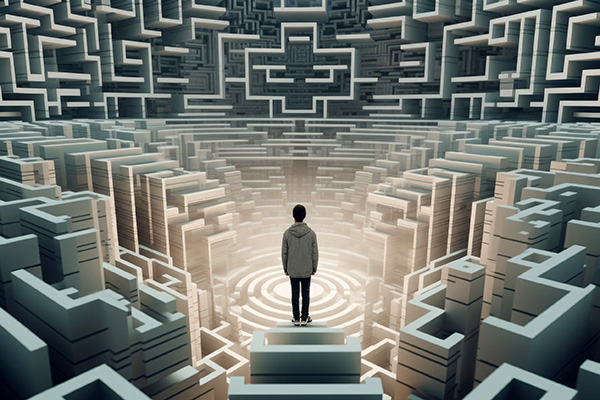gnosticism
Did Your Soul Choose Your Life Challenges?
 “Oh, why do I have such terrible karma?” or “Why does the universe keep throwing me curveballs?” or “Is God punishing me?” These are questions that clients often ask me when they face struggles in life.
“Oh, why do I have such terrible karma?” or “Why does the universe keep throwing me curveballs?” or “Is God punishing me?” These are questions that clients often ask me when they face struggles in life.
Spirit has repeatedly shown me in many readings over the years that we all have a kind of “architect’s plan” that we design before we incarnate into this life. This soul plan for our life journey lays out the lessons we’re going to learn and the experiences we’re going to have.
This spiritual principle is known by various names (depending on the context or belief system), including our spiritual blueprint, life design, divine plan, life script, soul contract, predestined path, and so on.
I prefer “architect’s plan” because it reminds me of the careful, meticulous planning an architect does when designing a new structure, long before the practical, hands-on construction takes place on site.
Like architects, we calmly and clearly create a plan for our life journey before we incarnate. It is only when we are here in the physical world to embody our plan that we fully experience the intensity and the many dangers and pitfalls that are part of our chosen journey, including all the fear, love, pain, hardship, joy, suffering, and everything in between.
Yes, it is hard to believe that we actually choose to face challenges and difficulties in our lives. But various spiritual traditions and esoteric philosophies tell us that our soul’s path is predestined or planned before we’re born, or at least that we have certain free will choices and options along the way.
Understanding The Higher Self
 In modern spirituality and metaphysics, the concept of the “higher self” is generally considered a cornerstone of spiritual awareness and conscious living.
In modern spirituality and metaphysics, the concept of the “higher self” is generally considered a cornerstone of spiritual awareness and conscious living.
The idea that we have a “higher self” is found in many spiritual and mystical traditions, although it may be called by different names and understood in different ways.
Despite these differences, the underlying idea is that there is a higher, more enlightened aspect of our being that we can connect with and embody.
Often mentioned in discussions of intuition, mindfulness, enlightenment, and the search for deeper meaning, the higher self is seen as a guiding force or eternal soure of wisdom that transcends our everyday consciousness.
Yet despite the common use of this term in modern spiritual communities and teachings, there remains a great deal of confusion and variation in how the higher self is understood and interpreted. There are many different opinions and beliefs. Some see it as our inner connection to the divine or universal consciousness. Others see it as the true spiritual essence, free from the limitations of the human ego. And some simply see it as an alternative term for our eternal spirit or soul identity.
In my experience, most of the confusion and misunderstanding arises because the higher self is mistakenly seen as a distinct and separate entity from the soul or spirit. From this perspective, the higher self is seen as entirely separate from our soul, representing our connection to something greater than ourselves, to the divine or universal consciousness.
Finding Peace In Your Natural State
 While doing a nature hike the other day, the thought occurred to me that we all come from nature, and we eventually also return to nature. This may be why we tend to feel so calm and peaceful when we are out in nature. When we smell a flower, hug a tree, or put our feet in the dirt, it reconnects us to our natural state and brings us back into balance.
While doing a nature hike the other day, the thought occurred to me that we all come from nature, and we eventually also return to nature. This may be why we tend to feel so calm and peaceful when we are out in nature. When we smell a flower, hug a tree, or put our feet in the dirt, it reconnects us to our natural state and brings us back into balance.
It has been scientifically proven that we essentially consist of ‘stardust.’ Our physical body is made of elements that were formed in the stars over the course of billions of years. Our bodies have about 97 percent of the same kind of atoms as that found in the galaxy. As the rock band Kansas so aptly proclaims, “Nothing lasts forever but the earth and sky. It slips away and all your money won’t another minute buy. Dust in the wind. All we are is dust in the wind.”
When you look up at the stars in a clear night sky, especially if you’re in a place where the air is clean and at a higher altitude, one can sometimes see the milky way. In such a moment of awe and wonder, it seems to me as if all time stands still. One’s everyday worries seem miniscule and trivial in comparison to the magnificent vastness and endless beauty of the cosmos.
Our connection to nature further brings to mind the classical elements of earth, water, air, fire, and aether that is still observed in various spiritual traditions, such as Ayurveda, Wicca and Gnosticism. Our existence in this life is essentially a magical alchemy of these elements.
In today’s world we tend to focus so much on how things should be, instead of how they actually are. Maybe much of our modern discontent stems from straying so far away from our natural state of being?
